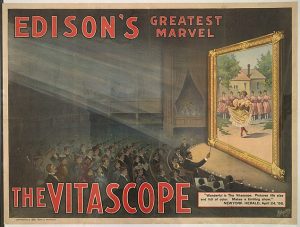By Dan Enos, CRRL Volunteer
Most Fredericksburg cinephiles have to content themselves with a life far removed from the gaudy glamour of the flashy film world that has its yearly peak as “award season” takes over Hollywood. However, if not for the ingenuity and tenacity of Fredericksburg-born entrepreneur and movie projector inventor Thomas Armat (1866-1948), the movie magic viewers take for granted today may have had a very different history.
Born on October 26, 1866, Mr. Armat spent his childhood living in a modest brick home at 611 Caroline St., which still stands today in the shadow of the Executive Plaza. In keeping with the innovative and industrial spirit of the late 19th century, Armat had both a knack for machinery and a creative mind. According to an April 2000 article in The Free Lance-Star, “in his spare time, he was the inventor of a variety of machinery including an oarlock for boats and an automatic car coupler for railroads.” He earned his first success in business as a real estate agent in Washington, D.C., which would later predate Hollywood as home to the burgeoning film industry. It was there that Armat teamed up with Charles Francis Jenkins to invent the motion picture projector. Inspired by the moving pictures featured in peep show booths at the Chicago World’s Fair in 1893, the two men sought a way to display images that could be seen by a large audience. Their initial creation failed, but Armat kept working on the idea and soon thereafter, without Jenkins’ help, he created a practical projector. He dubbed his invention the Phantoscope and it made its debut in September 1895 at the Cotton States Exposition in Atlanta, Georgia.
In 1896, Armat showed his projector to Thomas Edison, whose kinetoscope had been the inspiration for the new machine. Despite his reputation as one of America’s greatest visionaries, Edison apparently did not see much potential in the Phantoscope. Armat is quoted in his 1948 obituary as stating, “Mr. Edison didn’t think too much about it at first, but he agreed to manufacture the machine and he reluctantly agreed to have it known as Edison’s Vitascope.” Despite some later legal disputes over patent issues, Armat and Edison joined forces, forming the Motion Pictures Patent Company.
An early public showing of a motion picture in New York described in Armat’s obituary included “views of waves breaking against the English coast. The sea pictures drew cheers from the crowd and started a panicky commotion among those up front as the sea rushed toward them.”
Only months before his death at age 81, the Academy of Motion Picture Arts and Sciences awarded Armat a special Oscar, calling him “one of the great pioneers of our business whose historic contributions made possible the film industry of today.”
An archive of Armat’s papers, letters, and photographs is housed by the Booth Family Center for Special Collections at the Georgetown University Library.
Armat died on September 30, 1948, and was laid to rest several days later when his ashes were buried at Fredericksburg City Cemetery.
Most viewers of this year’s Oscars ceremony will never know of the invaluable contributions Fredericksburg’s own Thomas Armat made to the world of cinema. Perhaps if he had the same talent for self-promotion that Edison and so many of those who have populated the industry spawned by his idea have had, the world would know Armat’s name as well as it knows his invention.
Bibliography
Fitzgerald, Ruth Coder. “And the Oscar goes to…: Inventor Thomas Armat of Fredericksburg
Was a Pioneer in the Motion-Picture Industry with His 1895 Phantoscope.” The Free Lance-
Star, April 1, 2000.
Obituary. “Film Projector Co-inventor, Armat, City Native, Dead.” The Free Lance-Star, October 2,
1948.
Rough Sea at Dover (1895) was screened during the Vitascope's first theatrical exhibition on April 23, 1896.


